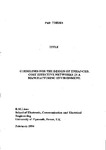GUIDELINES FOR THE DESIGN OF ENHANCED, COST EFFECTIVE NETWORKS IN A MANUFACTURING ENVIRONMENT
| dc.contributor.author | LINES, BENN MICHAEL | |
| dc.contributor.other | School of Engineering, Computing and Mathematics | en_US |
| dc.date.accessioned | 2013-09-10T10:08:31Z | |
| dc.date.available | 2013-09-10T10:08:31Z | |
| dc.date.issued | 1994 | |
| dc.identifier | NOT AVAILABLE | en_US |
| dc.identifier.uri | http://hdl.handle.net/10026.1/1623 | |
| dc.description.abstract |
Investigations into the transmission of real-time interactive speech over local area networks (LAN) in an industriai/commerciai environment to eventually obviate the need for a private automatic branch exchange and ultimately prepare the way for a single interactive integrated information system (PS) that provides work stations, which are networked via a LAN, with a fully interactive speech and graphics facility commensurate with the future requirements in computer integrated manufacturing (CIM). The reasons for conducting this programme of research were that existing LANs do not offer a real time interactive speech facility. Any verbal communication between workstation users on the LAN has to be carried out over a telephone network (PABX). This necessitates the provision of a second completely separate network with its associated costs. Initial investigations indicate that there is sufGcient capacity on existing LANs to support both data and real-time speech provided certain data packet delay criteria can be met. Earlier research work (in the late 1980s) has been conducted at Bell Labs and MIT. [Ref 25, 27 & 28], University of Strathclyde [Ref 24] and at BTRL [Ref 22 and 37]. In all of these cases the real time implementation issues were not fijlly addressed. In this thesis the research work reported provides the main criteria for the implementation of real-time interactive speech on both existing and newly installed networks. With such enhanced communication facilities, designers and engineers on the shop floor can be projected into their suppliers, providing a much greater integration between manufacturer and supplier which will be beneficial as Concurrent and Simultaneous Engineering Methodologies are further developed. As a result, various LANs have been evaluated as to their suitability for the transmission of real time interactive speech. As LANs, in general, can be separated into those with either deterministic or stochastic access mechanisms, investigations were carried out into the ability of both the: (i) Token Passing Bus LANs supporting the Manufacturing and Automation Protocol (MAP)—Deterministic and (u) Carrier Sense Multiple Access/Collision Detection (CSMA/CD) LANs supporting the Technical Office Protocol (TOP)— Stochastic to support real time interactive speech, as both are used extensively in commerce and manufacturing. The thesis that real time interactive speech can be transmitted over LANs employed in a computer integrated manufacturing environment has to be moderated following the tests carried out in this work, as follows:- The Token Passing LAN presents no serious problems under normal traffic conditions, however, the CSMA/CD LAN can only be used in relatively light traffic conditions i.e. below 30% of its designed maximum capacity, providing special arrangements are made to minimise the access, transmission and processing delays of speech packets. Given that a certain amount of delay is inevitable in packet switched systems (LANs), investigations have been carried out into techniques for reducing the subjective efifect of speech packet loss on real-time interactive systems due to the unacceptable delays caused by the conditions mentioned above. | en_US |
| dc.language.iso | en | en_US |
| dc.publisher | University of Plymouth | en_US |
| dc.title | GUIDELINES FOR THE DESIGN OF ENHANCED, COST EFFECTIVE NETWORKS IN A MANUFACTURING ENVIRONMENT | en_US |
| dc.type | Thesis | |
| plymouth.version | Full version | en_US |
| dc.identifier.doi | http://dx.doi.org/10.24382/4275 | |
| dc.identifier.doi | http://dx.doi.org/10.24382/4275 |
Files in this item
This item appears in the following Collection(s)
-
01 Research Theses Main Collection
Research Theses Main


